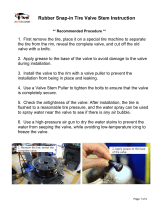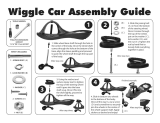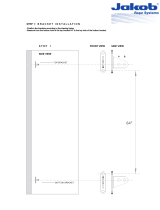Page is loading ...

KX450F
Motorcycle
Service Manual


This quick refe
rence guide will assist
you in locating a desired topic or pro-
cedure.
•Bend the pag
es back to match the
black tab of the desired chapter num-
ber with the black tab on the edge at
each table
of contents page.
•Refer to the sectional table of contents
for the exact pages to locate the spe-
cific to
pic required.
Quick Reference Guide
General Information 1
j
Periodic Maintenance 2
j
FuelSystem(DFI) 3
j
Cooling System 4
j
Engine Top End 5
j
Clutch 6
j
Engine Lubrication System 7
j
Engine Removal/Installation 8
j
Crankshaft/Transmission 9
j
Wheels/Tires 10
j
Final Drive 11
j
Brakes 12
j
Suspension 13
j
Steering 14
j
Frame 15
j
Electrical System 16
j
Appendix 17
j


KX450F
Motorcycle
Service Manual
All rights reserved. No parts of this publication may be reproduced, stored in a retrieval system, or
transmitted in any form or by any means, electronic mechanical photocopying, recording or otherwise,
without the prior written permission of Quality Assurance Division/Consumer Products & Machinery
Company/Kawasaki Heavy Industries, Ltd., Japan.
No liability can be accepted for any inaccuracies or omissions in this publication, although every possible
care has been taken to make it as complete and accurate as possible.
The right is reserved to make changes at any time without prior notice and without incurring an obligation
to make such changes to products manufactured previously. See your Motorcycle dealer for the latest
information on product improvements incorporated after this publication.
All information contained in this publication is based on the latest product information available at the time
of publication. Illustrations and photographs in this publication are intended for reference use only and may
not depict actual model component parts.
© 2008 Kawasaki Heavy Industries, Ltd. Second Edition (1) : May 25, 2009 (K)

LIST OF ABBREVIATIONS
A ampere(s) lb pound(s)
ABDC after bottom dead center m meter(s)
AC
alternating current min
minute(s)
ATDC after top dead center
N
newton(s)
BBDC before bottom dead center
Pa
pascal(s)
BDC bottom dead center PS horsepower
BTDC before top dead center psi pound(s) per square inch
°C degree(s) Celsius r revolution
DC direct current r/min, rpm revolution(s) per minute
F farad(s) TDC top dead center
°F degree(s) Fahrenheit TIR total i ndicator reading
ft foot, feet V volt(s)
g gram(s) (mass) W watt(s)
h hour(s) Ω ohm(s)
kg
(mass)
kgf (force)
L
liter(s)

Foreword
This manual is designed primarily for use by
trained mechanics in a properly equipped shop.
However, it contains enough detail and basic in-
formation to make it useful to the owner who de-
sires to perform his own basic maintenance and
repair work. A basic knowledge of mechanics,
the proper use of tools, and workshop proce-
dures must be understood in order to carry out
maintenance and repair satisfactorily. When-
ever the owner has insufficient experience or
doubts his ability to do the work, all adjust-
ments, maintenance, and repair should be car-
ried out only by qualified mechanics.
In order to perform the work efficiently and
to avoid c ostly mistakes, read the text, thor-
oughly familiarize yourself with the procedures
before starting work, and then do the work care-
fully in a c lean area. Whenever special tools or
equipment are specified, do not use makeshift
tools or equipment. Precision measurements
can only be made if the proper instruments are
used, and the use of substitute tools may ad-
versely affect safe operation.
To get the longest life out of your vehicle:
•
Follow the Periodic Maintenance Chart in the
Service Manual.
•
Be alert for problems and non-scheduled
maintenance.
•
Use proper tools and genuine Kawasaki Mo-
torcycle parts. Special tools, gauges, and
testers that are necessary when servicing
Kawasaki motorcycles are introduced by the
Service Manual. Genuine parts provided as
spare parts are listed in the Parts Catalog.
•
Follow the procedures in this manual care-
fully. Don’t take shortcuts.
•
Remember to keep complete records of m ain-
tenance and repair with dates and any new
parts installed.
How to U se This M
anual
In this manual, the product is divided into
its major systems and these systems make up
the manual’s c
hapters. The Quick Reference
Guide shows you all of the product’s system
and assists in locating their chapters. Each
chapter in t
urn has its own comprehensive Ta-
ble of Contents.
For example, if you want ignition coil informa-
tion, use t
he Quick Reference Guide to locate
the Electrical System chapter. Then, use the
Table of Contents on the first page of the chap-
ter to find the Ignition Coil section.
Whenever you see symbols, heed their in-
structions! Always follow s afe operating and
maintenance practices.
DANGER
DANGER indicates a hazardous situa-
tion which, if not avoided, will result in
death or serious injury.
WA RNING
WARNING indicates a hazardous situa-
tion which, if not avoided, could result
in death or serious injury.
CAUTION
CAUTION indicates a hazardous situa-
tion which, if not avoided, could result
in minor or moderate injury.
NOTICE
NOTICE is used to address practices not
related to personal injury.
This manual contains four more symbols
which will help you distinguish different types
of information.
NOTE
○
This no te symbol indicates points of par-
ticular interest for more efficient and con-
venient operation.
•
Indicates a procedural step or work to be
done.
○
Indicates a procedural sub-step or how to do
the work of the procedural step it follows. It
also precedes the text of a NOTE.
Indicates a conditional step or what action to
take based on the results of the test or inspec-
tion in the procedural step or sub-step it fol-
lows.
In most chapters an exploded view illustration
of the system components follows the Table of
Contents. In these illustrations you will find the
instructions indicating which parts require spec-
ified tightening torque, oil, grease or a locking
agent during assembly.


GENERAL INFORMATION 1-1
1
General Information
Table o f Contents
Before Servicing ..................................................................................................................... 1-2
Model Identification................................................................................................................. 1-7
General Specifications............................................................................................................ 1-8
Unit Conversion Table ............................................................................................................ 1-11

1-2 G ENERAL INFORMATION
Before Servicing
Before starting to perform an inspection service or carry out a disassembly and reassembly opera-
tion on a motorcycle, read the precautions given below. To facilitate actual operations, notes, illustra-
tions, photographs, cautions, and detailed descriptions have been included in each chapter wherever
necessary. This section explains the items that require particular attention during the removal and
reinstallation or disassembly and reassembly of general parts.
Especially note the following:
Edges of Parts
Lift large or heavy parts wearing gloves to prevent injury
from possible sharp edges on the parts.
Solvent
Use a high-flush point solvent when cleaning parts. High
-flush point solvent should be used according to directions
of the solvent manufacturer.
Cleaning vehic le before disassembly
Clean the vehicle thoroughly before disassembly. Dirt or
other foreign materials entering into sealed areas during ve-
hicle disassembly can cause excessive wear and decrease
performance of the vehicle.
Arrangement and Cle aning of Removed Parts
Disassembled parts are easy to confuse. Arrange the
parts according to the order the parts were disassembled
and clean the parts in order prior to assembly.

GENERAL INFORMATION 1-3
Before Servicing
Storage of Removed Parts
After all the parts including subassembly parts have been
cleaned, store the parts in a clean area. Put a clean cloth
or plastic sheet over the parts to protect from any foreign
materials that may collect before re-assembly.
Inspection
Reuse of worn or damaged parts may lead to serious ac-
cident. Visually inspect removed parts for corrosion, discol-
oration, or other damage. Refer to the appropriate sections
of this manual for service limits on individual parts. Replace
the parts if any damage has been found or if the part is be-
yond its service limit.
Replacement Parts
Replacement Parts must be KAWASAKI genuine or
recommended by KAWASAKI. Gaskets, O-rings, Oil seals,
Grease seals, circlips or cotter pins must be replaced with
new ones whenever disassembled.
Assembly Order
In most cases assembly order is the reverse of disassem-
bly, however, if assembly order is provided in this Service
Manual, follow the procedures given.
Tightening Sequence
Generally, when installing a part with several bolts, nuts,
or screws, start them all in their holes and tighten them to
a snug fit. Then tighten them according to the specified se-
quence to prevent case warpage or deformation which can
lead to malfunction. Conversely when loosening the bolts,
nuts, or screws, first loosen all of them by about a quar-
ter turn and them remove them. If the specified tightening
sequence i s not indicated, tighten the fasteners alternating
diagonally.

1-4 G ENERAL INFORMATION
Before Servicing
Tightening Torque
Incorrect torque applied to a bolt, nut, or screw may
lead to serious damage. Tighten fasteners to the specified
torque using a good quality torque wrench.
Often, the tightening sequence is followed twice-initial
tightening and final tightening with torque wrench.
Force
Use common sense during disassembly and assembly,
excessive force can cause expensive or hard to repair dam-
age. When necessary, remove screws that have a non
-permanent locking agent applied using an impact driver.
Use a plastic-faced mallet whenever tapping is necessary.
Gasket, O-ring
Hardening, shrinkage, or damage of both gaskets
and O-rings after disassembly can reduce sealing per-
formance. Remove old gaskets and clean the sealing
surfaces thoroughly so that no gasket material or other
material remains. Install new gaskets and replace used
O-rings when re-assembling
Liquid Gasket, Non-permanent Locking Agent
For applications that require Liquid Gasket or a
Non-Permanent Locking Agent, clean the surfaces so
that no oil residue remains before applying liquid gasket or
non-permanent locking agent. Do not apply them exces-
sively. Excessive application can clog oil passages and
cause serious damage.
Press
For items such as bearings or oil seals that must be
pressed into place, apply small amount of oil to the con-
tact area. Be sure to maintain proper alignment and use
smooth movements when installing.

GENERAL INFORMATION 1-5
Before Servicing
Ball Bearing and Needle Bearing
Do not remove pressed ball or needle unless removal is
absolutely necessary. Replace with new ones whenever
removed. Press bearings with the manufacturer and size
marks facing out. Press the bearing into place by putting
pressure on the correct bearing race as shown.
Pressing the incorrect race can cause pressure between
the inner and outer race and result in bearing damage.
Oil Seal, Grease Seal
Do not remove pressed oil or grease seals unless removal
is necessary. Replace with new ones whenever removed.
Press new oil seals with manufacture and size marks facing
out. Make sure the seal is aligned properly when installing.
Apply specified grease to the lip of seal before installing
the seal.
Circlips, Cotter Pins
Replace circlips or cotter pins that were removed with new
ones. Take care not to open the clip excessively when in-
stalling to prevent deformation.
Lubrication
It is important to lubricate rotating or sliding parts during
assembly to minimize wear during initial operation. Lubri-
cation points are called out throughout this manual, apply
the s pecific oil or grease as specified.

1-6 G ENERAL INFORMATION
Before Servicing
Direction of Engine Rotation
When rotating the crankshaft by hand, the free play
amount of rotating direction will affect the adjustment. Ro-
tate the crankshaft to positive direction (clockwise viewed
from output side).
Electrical Leads
A two-color lead is identified first by the primary color and
then the stripe color. Unless instructed otherwise, electrical
leads must be connected to those of the same color.
Instrument
Use a meter that has enough accuracy for an accurate
measurement. Read the manufacture’s instructions thor-
oughly before using the meter. Incorrect values may lead
to improper adjustments.

GENERAL INFORMATION 1-7
Model Identification
KX450E9F Left Side View
KX450E9F Right Side View
Frame Number Engine Number

1-8 G ENERAL INFORMATION
General Specifications
Items KX450E9F, EAF
Dimensions
Overall Length 2 185 mm (86.02 in.)
Overall Width 820 mm (32.3 in.)
Overall Height 1 280 mm (50.39 in.)
Wheelbase 1 480 mm (58.27 in.)
Road Clearance 340 mm (13.4 in.)
Seat Height 965 mm (38.0 in.)
Curb Mass: 112.1 kg (247.1 lb) (KX450E9F)
113.6 kg (250.5 lb), (EUR, BR) 113.5 kg (250.3 lb)
Front 54.4 kg (120 lb) (KX450E9F)
54.9 kg (121 lb)
Rear
57.7 kg (127 lb) (KX450E9F)
58.7 kg (129 lb), (EUR, BR) 58.6 kg (129 lb)
Fuel Tank Capacity 7.0 L (1.8 US gal)
Engine
Type
4-stroke, single cylinder, DOHC 4 valve
Cooling System Liquid-cooled
Bore and Stroke 96.0 × 62.1 mm (3.78 × 2.44 in.)
Displacement 449 cm³ (27.4 cu in.)
Compression Ratio 12.5 : 1
Carburetion System DFI (Digital Fuel Injection) System, KEIHIN 43
Starting System
Primary kick
Ignition System Digital DC-CDI
Timing Advance
Ignition Timing
BTDC 10° @2 000 r/min (rpm)
Spark Plug NGK CPR8EB-9
Valve Timing:
Inlet:
Open BTDC 34° (KX450E9F)
BTDC 36°
Close ABDC 70° (KX450E9F)
ATDC 68°
Duration 284°
Exhaust:
Open BBDC 66°
Close ATDC 38°
Duration 284°
Lubrication System Forced lubrication (semi-dry sump)
Engine Oil:
Grade API SG
API SH, SJ or SL with JASO MA, MA1 or MA2
Viscosity
SAE 10W-40
Capacity 1.2L(1.3USqt)

GENERAL INFORMATION 1-9
General Specifications
Items KX450E9F, EAF
Drive Train
Primary Reduction System:
Type Gear
Reduction Ratio
2.727 (60/22)
Clutch Type
Wet, multi disc
Transmission:
Type
5-speed, constant mesh, return shift
Gear ratios:
1st 1.750 (28/16)
2nd 1.412 (24/17)
3rd 1.188 (19/16)
4th 1.000 (19/19)
5th
0.875 (21/24)
Final Drive System:
Type Chain drive
Reduction Ratio 3.846 (50/13)
Overall Drive Ratio 9.178 @Top gear
Frame
Type Tubular, semi-double cradle
Steering Angle 42° to either side
Caster (rake angle) 26.7°
Trail 116 mm (4.57 in.)
Front tire:
Size 90/100-21 57M
Make/Type DUNLOP D742F, Tube type (KX450E9F)
BRIDGESTONE M403, Tube type
Rear tire:
Size 120/80-19 63M
Make/Type DUNLOP D756, Tube type (KX450E9F)
BRIDGESTONE M404, Tube type
Rim size:
Front 21 × 1.60
Rear 19 × 2.15
Front suspension:
Type Telescopic fork (up side down)
Wheel travel 315 mm (12.4 in.)
Rear suspension:
Type Swingarm (New Uni-trak)
Wheel travel 315 mm (12.4 in.)
Brake type:
Front and Rear Single disc

1-10 GENERAL INFORMATION
General Specifications
Items KX450E9F, EAF
Effective disc diameter:
Front (effect. dia.) 225 mm (8.86 in.)
Rear (effect. dia.) 215 mm (8.46 in.)
Specifications subject to change without notice, and may not apply to every country.

GENERAL INFORMATION 1-11
Unit Conversion Table
Prefixes for Units:
Prefix Symbol Power
mega M × 1 000 000
kilo k × 1 000
centi c ×0.01
milli m × 0.001
micro µ × 0.000001
Units of Mass:
kg × 2.205 = lb
g × 0.03527 = oz
Units of Volume:
L × 0.2642 =
gal (US)
L × 0.2200 = gal (imp)
L × 1.057 = qt (US)
L × 0.8799 = qt (imp)
L × 2.113 = pint (US)
L × 1.816 =
pint (imp)
mL × 0.03381 =
oz (US)
mL × 0.02816 = oz (imp)
mL × 0.06102 = cu in
Units of Force:
N × 0.1020 =
kgf
N × 0.2248 = lb
kgf × 9.807 = N
kgf × 2.205 = lb
Units of Length:
km × 0.6214 = mile
m × 3.281 = ft
mm × 0.03937 = in
Units of Torque:
N·m × 0.1020 = kgf·m
N·m × 0.7376 = ft·lb
N·m × 8.851 = in·lb
kgf·m × 9.807 = N·m
kgf·m × 7.233 = ft·lb
kgf·m × 86.80 = in·lb
Units of Pressure:
kPa × 0.01020 = k gf/cm²
kPa × 0.1450 = psi
kPa × 0.7501 = cm Hg
kgf/cm²
× 98.07 = kPa
kgf/cm² × 14.22 = psi
cm Hg × 1.333 = kPa
Units of Speed:
km/h × 0.6214 = mph
Units of Power:
kW × 1.360 = PS
kW × 1.341 = HP
PS × 0.7355 = kW
PS × 0.9863 = HP
Units of Temperature:

/




